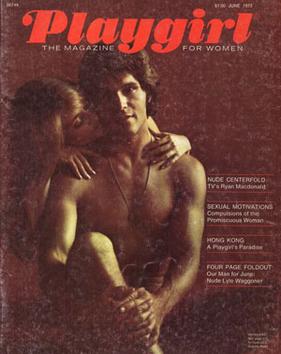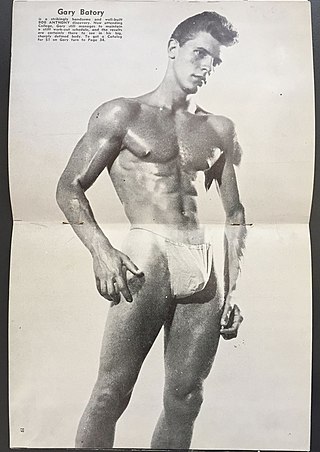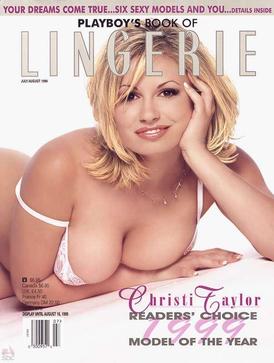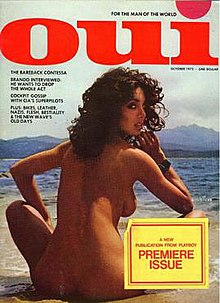
Hugh Marston Hefner was an American magazine publisher. He was the founder and editor-in-chief of Playboy magazine, a publication with revealing photographs and articles.

Playboy is an American men's lifestyle and entertainment magazine, formerly in print and currently online. It was founded in Chicago in 1953, by Hugh Hefner and his associates, funded in part by a $1,000 loan from Hefner's mother.
The Pubic Wars, a pun on the Punic Wars, was a rivalry between the American pornographic magazines Playboy and Penthouse during the 1960s and 1970s. Each magazine strove to show just a little bit more nudity on their female models than the other, without getting too crude. The term was coined by Playboy owner Hugh Hefner. In 1950s and 1960s United States, it was generally agreed that nude photographs were not pornographic unless they showed pubic hair or genitals. Mainstream mass-market photography was careful to come close to this line without stepping over it. Consequently, the depiction of pubic hair was de facto forbidden in U.S. pornographic magazines of the era.

Penthouse is a men's magazine founded by Bob Guccione and published by Los Angeles–based Penthouse World Media, LLC. It combines urban lifestyle articles and softcore pornographic pictures of women that, in the 1990s, evolved into hardcore pornographic pictures of women.

Playgirl is an American magazine that has historically featured pictorials of nude and semi-nude men alongside general interest, lifestyle, and celebrity journalism, as well as original fiction. For most of its history, the magazine printed monthly and was marketed mainly to women, though it quickly developed a significant gay male readership.

Softcore pornography or softcore porn is commercial still photography, film, or art that has a pornographic or erotic component but is less sexually graphic and intrusive than hardcore pornography, defined by a lack of visual sexual penetration. It typically contains nude or semi-nude actors involved in love scenes and is intended to be sexually arousing and aesthetically beautiful. The distinction between softcore pornography and erotic photography or art, such as Vargas girl pin-ups, is largely a matter of debate.

Shere Hite was an American-born German sex educator and feminist. Her sexological work focused primarily on female sexuality. Hite built upon biological studies of sex by Masters and Johnson and by Alfred Kinsey and was the author of The Hite Report: A Nationwide Study on Female Sexuality. She also referenced theoretical, political and psychological works associated with the feminist movement of the 1970s, such as Anne Koedt's essay "The Myth of the Vaginal Orgasm". She renounced her United States citizenship in 1995 to become German.

Pornographic magazines or erotic magazines, sometimes known as adult magazines or sex magazines, are magazines that contain content of an explicitly sexual nature. Publications of this kind may contain images of attractive naked subjects, as is the case in softcore pornography, and, in the usual case of hardcore pornography, depictions of masturbation, oral, manual, vaginal, or anal sex.

The centerfold or centrefold of a magazine is the inner pages of the middle sheet, usually containing a portrait, such as a pin-up or a nude. The term can also refer to the model featured in the portrait. In saddle-stitched magazines, the centerfold does not have any blank space cutting through the image.
Jon Carroll is a retired newspaper columnist, best known for his work for the San Francisco Chronicle from 1982, when he succeeded columnist Charles McCabe, to 2015, when he retired. His column appeared on the back page of the Chronicle's Datebook section Tuesdays through Fridays.
Leslie Marie Graves was an American actress.

Mandate was a monthly pornographic magazine for gay men. It was published in the United States and distributed internationally since April, 1975. Together with the other magazines of the Mavety Group, such as Black Inches, it folded in 2009.

Gallery is an adult sex magazine published by Magna Publishing Group. It is one of the more popular "skin" magazines that arose on the Playboy magazine pattern in the 1970s.
Philip Nobile is an American freelance writer, journalist, historian, teacher, and social critic/commentator. He has written or edited several books, published investigative journalism in leading newspapers and journals, and taught at the Cobble Hill School of American Studies, a public school in Brooklyn.

Rogue was a Chicago-based, men's magazine published by William Hamling from 1956 until 1965. Founding editor Frank M. Robinson was followed by other editors, including Harlan Ellison and Bruce Elliott. The magazine was subtitled "Designed for Men."

William Lawrence Hamling was an American writer, science fiction fan, and publisher of both science fiction digests, and adult magazines and books, active from the late 1930s until 1975. He was a lifelong member of First Fandom.
Mike Edison is a New York-based writer, editor, musician, social critic, and spoken word artist. He was one of many publishers/editors of the marijuana counterculture magazine High Times, and was later named editor-in-chief of Screw, the self-proclaimed "World's Greatest Newspaper." In his memoir I Have Fun Everywhere I Go, Edison recounts his adventures across twenty years of druggy adventurism and his parallel careers as a magazine editor, writer, and musician. His other books include the sprawling history of American men's magazines, Dirty! Dirty! Dirty!: Of Playboys, Pigs, and Penthouse Paupers, An American Tale of Sex and Wonder; the political satire Bye, Bye Miss American Pie; several collaborations including Restaurant Man with Joe Bastianich and The Carnivore's Manifesto with Slow Food USA founder Patrick Martins; and most recently, Sympathy for the Drummer: Why Charlie Watts Matters, a history and appreciation of the Rolling Stones drummer Charlie Watts, and the history of blues and rock ’n ’roll drumming. Edison speaks frequently on free speech, and the American counterculture. Between 2011 and 2018, Edison was the host and producer of the weekly Heritage Radio Network series Arts & Seizures.

There has been demand for imagery of nude celebrities for many decades. It is a lucrative business exploited by websites and magazines.

Playboy Special Editions are a spin-off series of Playboy magazine containing glamour and softcore nude photographs. The initially infrequent and later semi-regular editions ran from 1963 through 2000 then re-branded from 2000 through 2012 final issues. A one-off special edition was published in February 2015 featuring images of models in different locations within California from the controversial photographer Terry Richardson.














